Access Punjab land records conveniently on the Jamabandi portal
In Punjab, the State Revenue Department manages land records, which is referred to as Jamabandi. These papers are essential to prove ownership of land and come in handy when applying for a home loan.
The Punjab Land Records Society (PLRS) maintains and updates digitised land records in the state. To make these records more accessible, PLRS has launched a portal named Jamabandi Punjab.
The portal helps you to:
Find Jamabandi, mutation, and mutation-after-registry records
Check mutation status
Access Roznamcha (mutation details)
Request for Fard (title document) and check status
Check details from the property tax register
Search information for court cases related to land records
Verify Nakal and access the registry deed
Land records are pivotal documents for ownership rights, land revenue, and transactions. Check the table below to learn about the Punjab Land Records Society, its functions, and more.
Established By |
Government of Punjab |
Official Website |
|
Law Governing the Body |
Registration of Societies Act, 1860 |
Functions |
|
Headquarters |
Kapurthala Road, Jalandhar – 144001 |
PLRS has made land ownership details available online on the Jamabandi Punjab portal. Here is how you can access these records:
1. Visit the official website of Jamabandi Punjab

2. Select the Jamabandi period as ‘Current’ or ‘Previous’ on the home page
3. Choose the name of your district, tehsil, village, and year
4. Click on ‘Set Region’

5. Select the ‘Jamabandi’ option on the dashboard
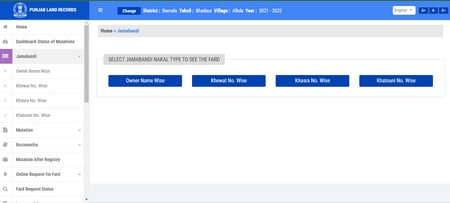
6. Check the details using the ‘Owner’s Name’, ‘Khewat No’, ‘Khasra No’, or ‘Khatouni No’
7. Enter the relevant information to check the land record details
These simple steps will help you check your loan records with the help of the mutation number:
1. Visit the official website of Punjab land records

2. Choose from the ‘Current’ or ‘Previous’ jamabandi period options\
3. Select the name of your district, tehsil, village, and year
4. Click on ‘Set Region’
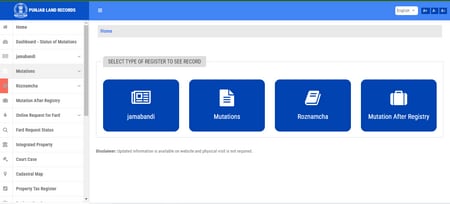
5. Click on the ‘Mutation’ option

6. Provide the mutation number and then enter the generated captcha code
7. Click on ‘View Report’ to check the details
Follow these steps to quickly check your land records online, using the Rapat number:
1. Visit the official website for PLRS

2. Select the Jamabandi period as ‘Current’ or ‘Previous’
3. Enter the name of your district, tehsil, village, and year
4. Click on ‘Set Region’
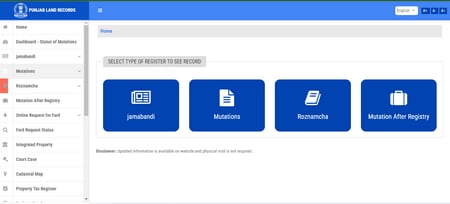
5. Select the ‘Roznamcha’ option

6. Click on ‘Rapat No. Wise’

7 .Enter the year, Rapat number, and the genenrated captcha
8. Next, click on the ‘View Report’ option to check the land records
To check your Punjab land records by using the Vaseeka or mutation request number, adhere to these easy steps:
1. Visit the official Jamabandi portal
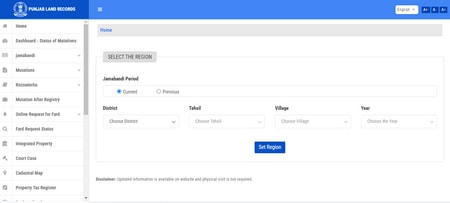
2. Select the Jamabandi period as ‘Previous’ or ‘Current’
3. Enter your district, tehsil, village, and year
4. Click on ‘Set Region’
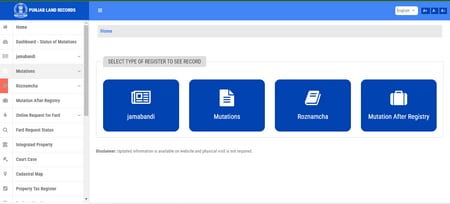
5. Select the ‘Mutation After Registry’ option
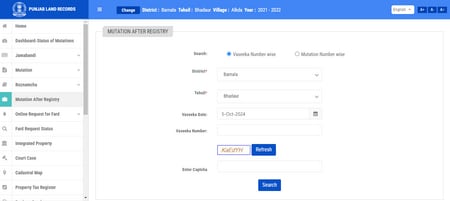
6. Choose from ‘Vaseeka Number wise’ or ‘Mutation Number wise’ as per your convenience
7. Enter the details and the captcha code as requested
8. Click on ‘Search’ to check the information of your land records
Follow these steps to raise a request for correction:
Visit https://jamabandi.punjab.gov.in/
Select ‘Correction in Record’ from the navigation pane on the left side
Enter your name, mobile number, and email ID
Choose your district, tehsil, and village
Select the relevant category (Jambandhi, Mutation, Rojnamcha, Other) from the ‘About’ dropdown
Enter the feedback and click on the ‘Submit’ button
Here is how you can check their status:
Go to the official website of Jamabandi Punjab
Click on the ‘Dashboard – Status of Mutation’ category
You can now see the state view of the mutation status
You can also view the status of a particular district by selecting one from the dropdown
A registry deed is a crucial document for transactions related to land underlying the transfer of land from one party to another. Follow these steps to access these documents:
Click on the ‘Registry Deed’ option on the homepage of the Jamabandi website
Choose your district and tehsil
Search by ‘Seller/Buyer Name’ or ‘Khewat No’ or ‘Registration No’ or ‘Registration Date’
Enter the ‘Seller/Buyer Name’
Click on the ‘Search’ button to get details
‘Nakal’ is a copy of the land documents, which you must verify to ensure everything is in order. Here is how you can do it on the PLRS portal:
Navigate to the ‘Nakal Verification’ tab on the homepage
Choose the district and tehsil
Select the required dates
Click on ‘Verify Nakal’
To register a complaint or get a resolution for an issue related to land records, you can contact the concerned authorities through:
Address: Director Land Records, Office of Director Land Records, Kapurthala Road, Jalandhar – 144001
Phone: 0181 225 4018
Portals to Check Land Records & EC
- Banglarbhumi
- Meebhoomi
- IGRSUP
- Bhulekh Odisha
- Jamabandi Haryana
- Kaveri Online Services
- IGR Odisha
- Apna Khata Rajasthan
- Jharbhumi
- E Swathu Karnataka
- IGR Maharashtra
- IGRS Andhra Pradesh
- IGRS Telangana
- Devbhoomi Uttarakhand Land Record
- Bhoomi Karnataka
- Jamabandi HP Land Record
- Patta Chitta
- ANY ROR Gujarat Land Record
State Wise Land Records
- Bhulekh UP Land Record
- Arunachal Pradesh Land Record
- Bhulekh Bihar Land Record
- MP Bhulekh Land Record
- Kerala Land Records eRekha
- Jammu And Kashmir Land Record
- Nagaland Land Records
- Bhuiyan Chhattisgarh Land Records
- Assam Land Records
- Dharani Maa Bhumi Telengana Land Records
- Bhulekh Maharashtra Land Record
- Delhi Land Records
- Jami Tripura Land Records
- Manipur Land Record
- Goa Land Record
Frequently Asked Questions
What are the different search options to view land records in Punjab?
You can search Punjab land records by owner name, Khewat number, Khasra number, or village.
What is Fard?
Fard is an official land ownership document used to verify the rights of property owners in Punjab.
What is Jamabandi?
Jamabandi is a record of land rights and ownership, showing details like landholders, cultivation, and revenue.
How to verify Nakal?
You can verify Nakal (a certified copy of land records) online through the Punjab land records portal using the Nakal verification option.
What are the different ways I can search for Roznamcha?
Roznamcha can be searched online by Khasra number or date on the Punjab land records portal.
How do you read Jamabandi?
Jamabandi records details of landholders, the land size, type of land, and government dues, organised by Khewat and Khasra numbers.
Is Jamabandi proof of ownership?
Yes, Jamabandi serves as a primary record of land ownership and rights in Punjab. It is accepted as proof of ownership in many legal and administrative matters related to land. However, for certain legal proceedings or transactions, additional documents may still be required.





